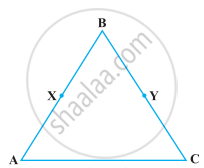Advertisements
Advertisements
Question
Given three distinct points in a plane, how many lines can be drawn by joining them?
Solution
Given three distinct points A, B and C in a plane, they can either be collinear or non collinear.
If they are collinear, then there can be only one line joining them.

If they are non collinear, then there can be three lines joining them.
For example, if we have three distinct non collinear points P, Q and R. Then we can draw three lines l, mand n joining them.

APPEARS IN
RELATED QUESTIONS
How many lines can be drawn through a given point.
How many planes can be made to pass through three distinct points?
Euclid belongs to the country ______.
Euclid stated that all right angles are equal to each other in the form of ______.
If a quantity B is a part of another quantity A, then A can be written as the sum of B and some third quantity C.
Solve the following question using appropriate Euclid’s axiom:
In the following figure, we have AB = BC, BX = BY. Show that AX = CY.

Read the following statement :
An equilateral triangle is a polygon made up of three line segments out of which two line segments are equal to the third one and all its angles are 60° each.
Define the terms used in this definition which you feel necessary. Are there any undefined terms in this? Can you justify that all sides and all angles are equal in a equilateral triangle.
Read the following two statements which are taken as axioms:
- If two lines intersect each other, then the vertically opposite angles are not equal.
- If a ray stands on a line, then the sum of two adjacent angles so formed is equal to 180°.
Is this system of axioms consistent? Justify your answer.
Read the following axioms:
- Things which are equal to the same thing are equal to one another.
- If equals are added to equals, the wholes are equal.
- Things which are double of the same thing are equal to one another.
Check whether the given system of axioms is consistent or inconsistent.
The following statement is true or false? Give reason for your answer.
If two circles are equal, then their radii are equal.
